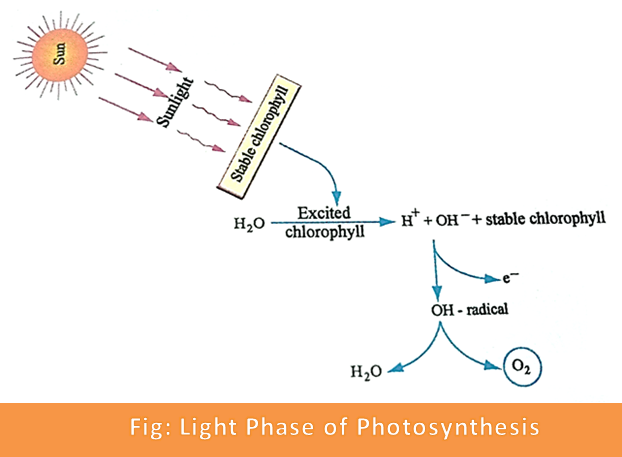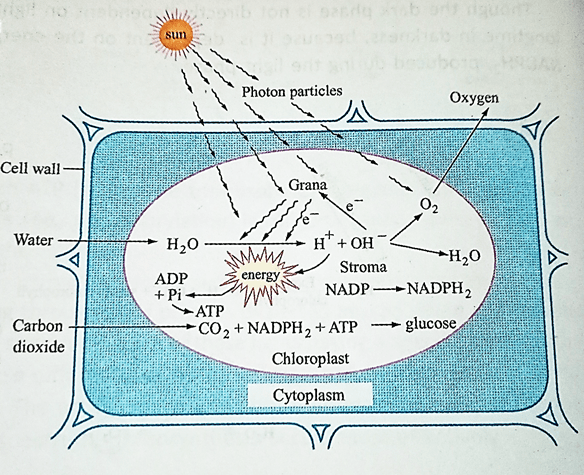Light Phase of Photosynthesis:
1. This is the first phase of photosynthesis.
2. Light-dependent process occurs in the grana of chloroplastids.
3. in the process solar energy is converted to chemical energy.
4. the chlorophyll molecules present in the grana of chloroplastids are activated by photons, the highly energized invisible tiny particles present in the sunlight.
5. Water absorbed by the unicellular root hairs is conducted to the mesophyll cells of the leaves of green plants. Within these cells, water then enters the chloroplastids, through diffusion. When this water comes in contact with the light-activated chlorophyll molecules. It splits up into H+ and OH– ions.

This process of splitting of H2O into H+ ion and OH– ion by the light-activated chlorophyll is called photolysis of water. This reaction was first formulated by Robin Hill in 1937. So, it is also called the Hill reaction. NADP which acts as a hydrogen acceptor in the Hill reaction is called Hill reactant or reagent.
6. The light-activated chlorophyll molecule (through absorption of photons of sunlight) liberates or ejects electrons, which are taken up by suitable electron acceptors. Energy from the liberated electrons is used to combine ADP (Adenosine Diphosphate) with Pi (inorganic phosphate) to form ATP (Adenosine Triphosphate), an energy-rich compound.

This process of the addition of phosphate group occurs in presence of sunlight, so this process is called photophosphorylation. The electrons by losing energy either return to the chlorophyll molecule (oxidized form) so as to convert it to a normal state. It is used to reduce NADP molecules along with H+ (liberated during photolysis of water).
Dark Phase of Photosynthesis:
1. This phase is not dependent on light, so it is also called the light-independent phase of photosynthesis. As already stated, this phase is also called C3 cycle or Calvin cycle. It is called the light-independent phase because it is not directly dependent on light. But it operates with the help of energy-rich compounds like ATP and NADPH2 produced during the light phase.
2. It occurs in the stroma of chloroplastids.
3. In this phase, the green plants absorb carbon dioxide from nature and combine it with Ribulose Bisphosphate (RuBP) to form two molecules of phosphoglyceric acid (PGA). The latter is the first stable photosynthetic product. This process is controlled by RUBISCO (RuBP Carboxylase Oxygenase) which is the key enzyme for CO2 fixation in green photosynthetic plants.
Rules of RUBISCO: It helps in CO2 fixation and convert Ribulose Bisphosphate to the 3 carbon sugar Phosphoglyceric Acid (PGA).
4. The PGA is then reduced to phosphoglyceraldehyde (PGAld) with the help of ATP and NADPH2 generated in the light phase.
5. A portion of PGAld molecules later condense to produce glucose through the formation of different intermediate products.
6. The remaining PGAld molecules are used to regenerate RuBP so that the process can continue on its own.